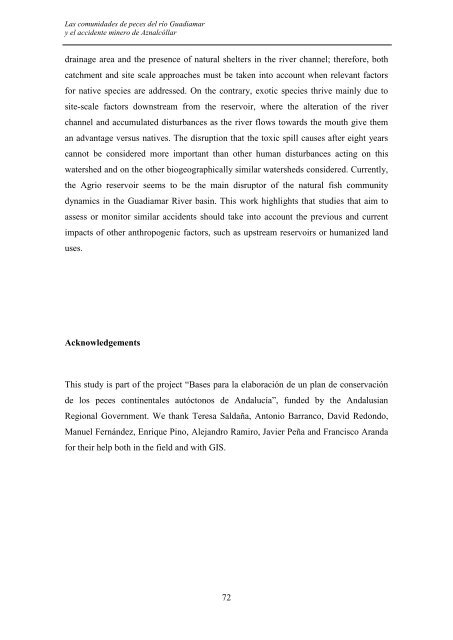las comunidades de peces del río guadiamar y el accidente minero ...
las comunidades de peces del río guadiamar y el accidente minero ...
las comunidades de peces del río guadiamar y el accidente minero ...
Create successful ePaper yourself
Turn your PDF publications into a flip-book with our unique Google optimized e-Paper software.
Las <strong>comunida<strong>de</strong>s</strong> <strong>de</strong> <strong>peces</strong> <strong>de</strong>l <strong>río</strong> Guadiamar<br />
y <strong>el</strong> acci<strong>de</strong>nte <strong>minero</strong> <strong>de</strong> Aznalcóllar<br />
drainage area and the presence of natural sh<strong>el</strong>ters in the river chann<strong>el</strong>; therefore, both<br />
catchment and site scale approaches must be taken into account when r<strong>el</strong>evant factors<br />
for native species are addressed. On the contrary, exotic species thrive mainly due to<br />
site-scale factors downstream from the reservoir, where the alteration of the river<br />
chann<strong>el</strong> and accumulated disturbances as the river flows towards the mouth give them<br />
an advantage versus natives. The disruption that the toxic spill causes after eight years<br />
cannot be consi<strong>de</strong>red more important than other human disturbances acting on this<br />
watershed and on the other biogeographically similar watersheds consi<strong>de</strong>red. Currently,<br />
the Agrio reservoir seems to be the main disruptor of the natural fish community<br />
dynamics in the Guadiamar River basin. This work highlights that studies that aim to<br />
assess or monitor similar acci<strong>de</strong>nts should take into account the previous and current<br />
impacts of other anthropogenic factors, such as upstream reservoirs or humanized land<br />
uses.<br />
Acknowledgements<br />
This study is part of the project “Bases para la <strong>el</strong>aboración <strong>de</strong> un plan <strong>de</strong> conservación<br />
<strong>de</strong> los <strong>peces</strong> continentales autóctonos <strong>de</strong> Andalucía”, fun<strong>de</strong>d by the Andalusian<br />
Regional Government. We thank Teresa Saldaña, Antonio Barranco, David Redondo,<br />
Manu<strong>el</strong> Fernán<strong>de</strong>z, Enrique Pino, Alejandro Ramiro, Javier Peña and Francisco Aranda<br />
for their h<strong>el</strong>p both in the fi<strong>el</strong>d and with GIS.<br />
72

















